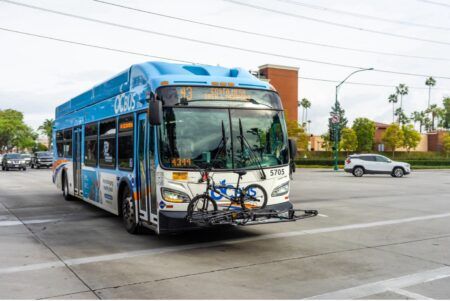In cooperation with South Gloucestershire Council (SGC), the Venturer project consortium has carried out the UK’s first driverless vehicle demonstration involving wireless communication between a bus and car that tested ‘look ahead’ functionality.
The Venturer team undertook the UK’s first on-road demonstration of a driverless car interacting with a bus. The innovative trial was the first of its kind and took place on Long Mead in South Gloucestershire, a 30mph (50km/h) bus-only road that follows the south west perimeter of the University of the West of England’s (UWE) Frenchay Campus in Bristol.
The demonstration involved the Venturer Wildcat (a BAE vehicle equipped with connected and autonomous technology), a single decker bus provided by First Bus UK, and another unmodified vehicle.
The aim was to test ‘look ahead’ functionality, where the autonomous system – including sensors (provided by Fusion Processing), a wireless communications system (provided by the University of Bristol) and the vehicle’s Decision-Making System (DMS) (provided by the Bristol Robotics Laboratory) – enabled the Wildcat to be notified that the road ahead was clear, so the vehicle could then safely navigate around a stopped bus despite having obstructed vision. Another scenario was undertaken when there was no oncoming vehicle and the Wildcat was able to make an immediate ‘go’ decision to continue around the bus without the need to stop.
The Wildcat/bus demonstration has shown an example of how connected and autonomous technologies can be used on different types of vehicles to complement and support the safe performance of CAVs as part of the wider transport network.
The demonstration was one of the first explorations of the interaction between connectivity and autonomy, with many other trials in the UK focusing on either connectivity for driver advisory systems, or autonomy for self-contained automated driving. The demonstration was part of the third Venturer trial that also comprises participant trials, the results of which will be published in June.
SGC is one of the Venturer consortium members and was the trial’s responsible highway authority, facilitating the necessary legal requirements to carry out the demonstration. Council leader Toby Savage said, “As a local authority, we are proud to be one of the country’s leading centers for innovation and at the forefront of connected and autonomous vehicle (CAV) research and development.
“As a place where industry and research institutes are already choosing to innovate, we are open to providing the infrastructure, platforms and resource at our disposal to support innovation.
“Our involvement in projects such as Venturer brings us invaluable learning at no cost to the local council tax payer, and should help us be better prepared for the future and maximize on any associated cost savings. This experience also puts us in a position to advise other local authorities and organizations.”
Venturer project manager Carolyn Mitchell of Atkins noted, “We believe that this aspect of Trial 3 demonstrates great project progression and puts the West of England at the forefront of CAV testing in the UK.
“To our knowledge no other UK CAV projects have yet tested autonomous technology interactions between a CAV and a bus. The bus demonstration represented a step change in technical, safety and management challenges due to its location on an open road, and the resulting potential for interactions with members of the public and their vehicles.”




